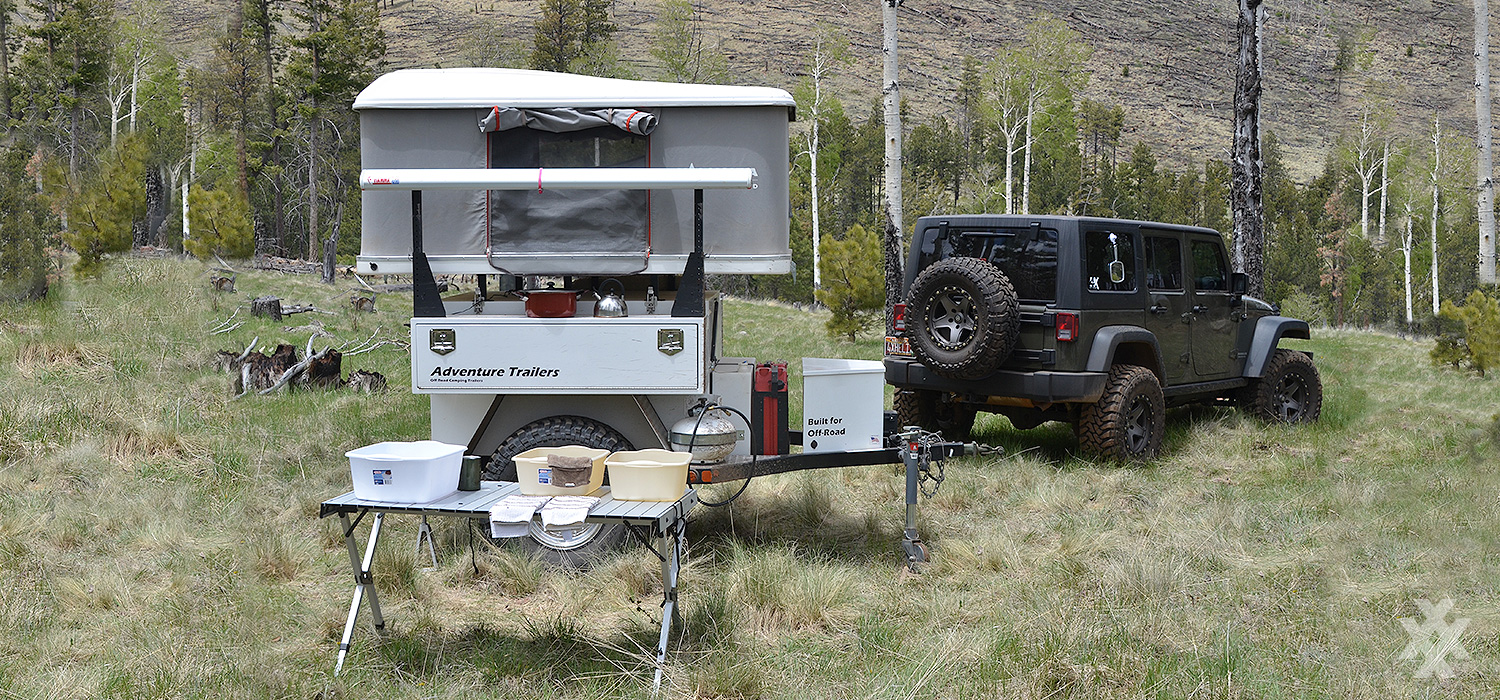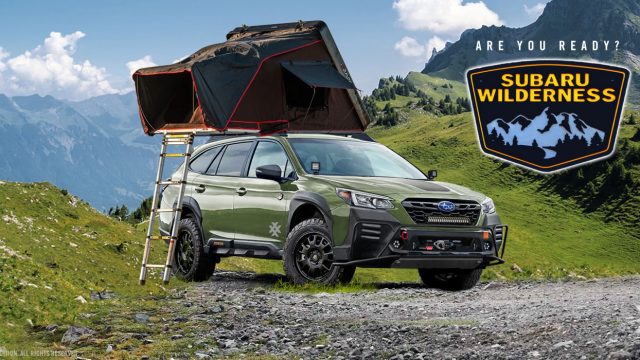I’ve spent a great deal of time researching and ultimately testing several adventure vehicle setups over the past 10 years. If you’ve followed my story you already know that I have traveled extensively in, primarily, five different adventure rig scenarios:
A lifted Jeep Rubicon with an off-road camper trailer in tow
An all-wheel-drive wagon sporting a rooftop tent
A 4×4 Pickup truck hauling a light-weight slide-in pop-up truck camper
A diesel Mercedes Benz Sprinter Camper
Any car I had at the time with a pup tent onboard

There are a great deal of pros and cons when it comes to making your best selection for the job at hand and unfortunately, I have discovered there is no silver bullet. Nonetheless, this article is to address some of the benefits and detriments of several different rig scenarios to help you arrive at a possible solution to fit the needs of outdoor adventurers. Note that because of the pandemic, supply chains are compromised and thus the wait list to obtain any of the more complex options below–other than tent equipment–can be not only challenging but sufficiently annoying. So, let’s get started.
To follow you will find the scenarios I have personally considered and researched extensively. Some of these scenarios turned into reality for me which gave me a real hands-on opportunity to experience adventures using them. And, if you follow my travels, you will know that I have yet to settle on a setup that works for every adventure.
- Camping with a tent or sleeping inside of a high-clearance vehicle
- High-clearance vehicle with a mounted rooftop tent
- High-clearance vehicle towing an off-road overland trailer (mounted with a rooftop tent or enclosed sleeping arrangement such as a teardrop)
- High-clearance pick-up truck hauling a slide in truck camper
- High-clearance camper van or off-road chassis overland camper
- High-clearance pickup truck equipped with a shell mounted with a rooftop tent pulling a camper trailer
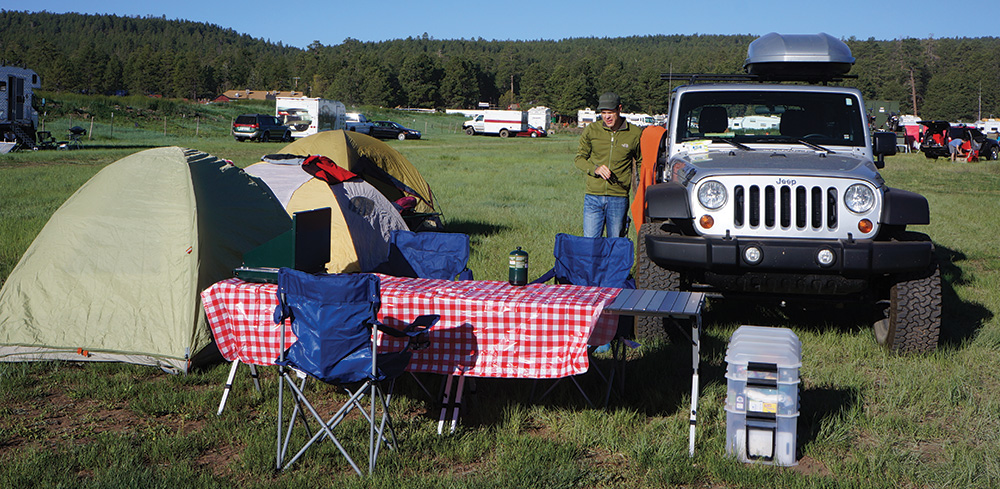
Tent Camping
If you are reading this, I’d bet $20 bucks you’ve camped in a tent next to your car. Car camping is generally the first toe dip into exploring other rig options and solutions to your camping adventure needs. And, why not, it’s tried and true and the cost of entry is entirely affordable to most people no matter what their budget. If you are looking to explore any distance from your home, you don’t really need much other than your vehicle and a tent.
Pros:
- Cost of entry
- Simplicity of equipment (loading vehicle)
- Off-road access to remote destinations
Cons:
- Safety concerns when sleeping outside locked vehicle (human/animal interaction)
- Subject to foul weather (when sleeping, preparing meals, and relaxing)
- Limited comfort (depending on selected options)
- Limited camp site locations (smooth flat surfaces only)
- Inconvenience and time investment to load and unload gear
- Gear storage at home
- Camping restrictions in bear country (National Parks)
- Stealth camping in urban environments not an option
- No option for online camping services (Harvest Host – must have onboard services)
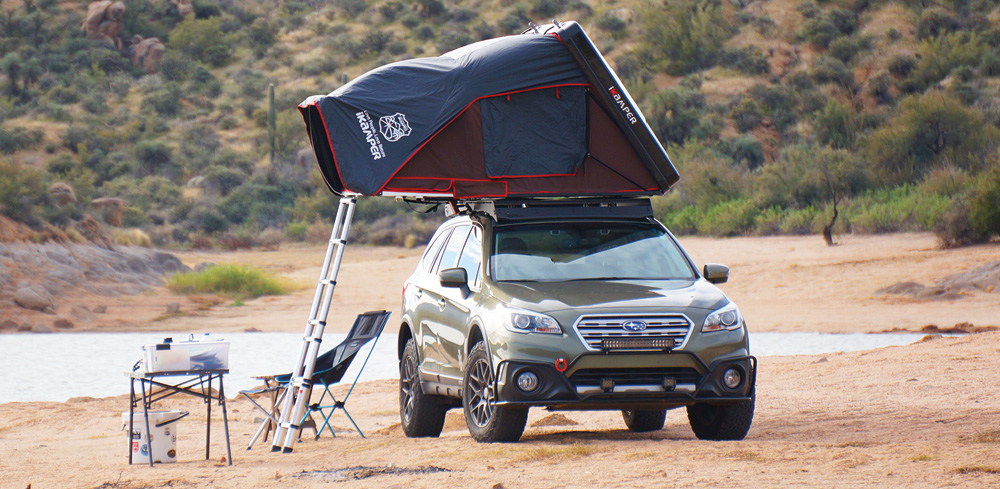
Mounted Rooftop Tent
Rooftop tents have made significant in-roads into the world of vehicular adventure travel. Manufacturers have continually improved both form and function. Today the cost of a rooftop tent has seen a significant decrease. Prices for rooftop tents now range from as little as $800 and sell for as much as $5,000. There are different types of rooftop tents including hard-shell or clam-shell models as well as soft-sided models. And, as would be expected, there are benefits and detriments to both. I won’t cover the different tent options here as I am more interested in sharing the primary rig options. The pros below also reflect the inclusion of a vehicle awning.
Pros:
- Speed to departure (tent and sleep system always on-board)
- Positions occupants high up off the ground
- Improved safety when sleeping (animal interaction)
- Improved experience in foul weather (sleeping and relaxing)
- Quick setup and take down (even better with a clam-shell model)
- Full-time storage of sleeping system (depending on tent model and interior closed space)
- Improved comfort over tent camping (mattress and warmth- relaxing in foul weather)
- Off-road access to remote destinations
- Unlimited camp site locations (no smooth surfaces required)
Cons:
- Cost of entry (depending on the model)
- Full-time tent mounted to your roof (unless you have a garage lift to remove it)
- Decreased fuel efficiency (caused by wind drag)
- Reduction in vehicle height clearance (in your garage, parking garage, other low clearance)
- Airing out the tent after foul weather while mounted on your vehicle
- Subject to tent flapping in high winds (depending on the model)
- Once set-up, vehicle must remain stationary (No driving around to explore surroundings)
- Safety concerns when sleeping outside locked vehicle (human/animal interaction)
- Living space subject to foul weather
- Camping restrictions in bear country (soft-sided popups) (National Parks)
- Stealth camping in urban environments not an option
- No option for online camping services (Harvest Host – must have onboard services)

Towing an Off-road Trailer
I have to say I enjoyed owning my Jeep Rubicons with a Adventure Trailers Horizon off-road camper trailer in tow. I enjoyed the convenience of just hooking up a trailer and taking off with all of my gear stored inside. I also appreciated the ability I had to disconnect the trailer and drive my Jeep around independent of my camper system. Yet, there were situations where I was less than excited about the setup.
Pros:
- Speed to departure (improved over the previous options)
- Full-time storage of complete camping system
- Onboard kitchen, water, propane, power, refrigeration
- Off-road access to remote destinations (articulating hitch/high clearance)
- Easy disconnect to explore the area with your vehicle (after setup)
- Improved safety when sleeping (animal interaction)
- Ease of towing (depending on size and weight of model)
- Less or no equipment and gear loaded in vehicle (all stored in trailer)
- Ample storage space for additional gear (paddle boards, surf boards, fishing)
Cons:
- Cost of entry (base trailers start at no less than $10,000 and up)
- Must fill tanks, maintain batteries before departure and while storing
- Must lock trailer to reduce risk of theft while storing (trailer and contents)
- Inconvenient in urban areas for parking and maneuvering
- Decreased fuel efficiency caused by towing
- Increased off-road safety concerns (rolling and damaging the trailer)
- Safety concerns when sleeping outside locked vehicle (human/animal interaction)
- Living space subject to foul weather
- Stealth camping in urban environments not an option
- Camping restrictions in bear country (soft-sided popups) (National Parks)
- Stealth camping in urban environments not an option
- No option for online camping services (Harvest Host – must have onboard services)
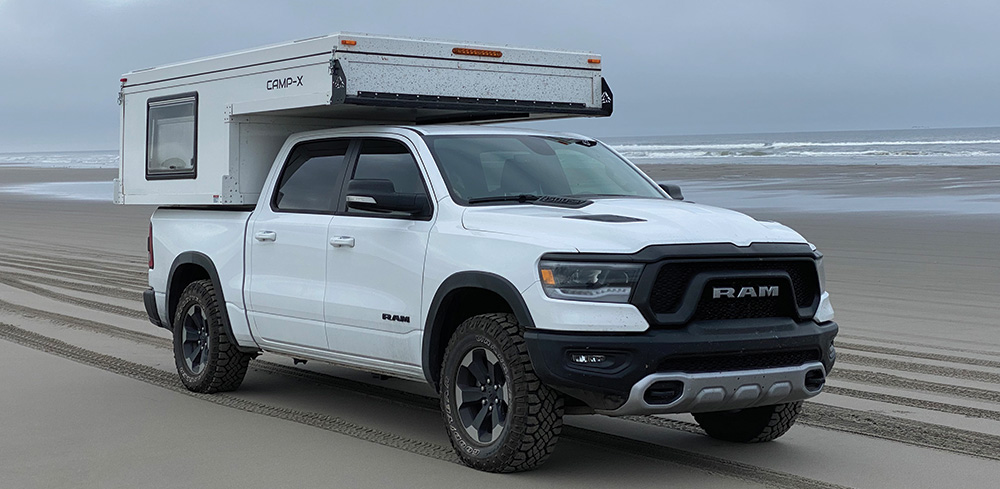
Pickup Hauling a Truck Camper
As many of you reading this may recall, I purchased and utilized a Overland Explore Camp X light weight slide-in, pop-up, four season truck camper for my 2020 Ram Rebel 1500 4×4 pick-up truck. I found this camper option to be quite convenient and comfortable and enjoyed some amazing travel adventures with that set-up. There are a wide range of options when it comes to truck campers. Costs range greatly along with camper dry weight. And, the larger the camper the more powerful the truck must be. Below are several of my observations from my experience.
Pros:
- Speed to departure (improved over the previous options)
- Full-time storage of complete camping system
- Onboard kitchen, water, propane, power, refrigeration
- Off-road access to remote destinations (articulating hitch/high clearance)
- Improved safety when sleeping (animal interaction)
- Optional online camping services (Harvest Host – must have onboard services)
Cons:
- Cost of entry (base models start in the range of $25,000)
- Must fill tanks, maintain batteries before departure and while storing
- Decreased fuel efficiency (caused by weight and drag)
- Decreased clearance in urban areas and in tree cover
- Camping restrictions in bear country (if a soft-sided popup model) (National Parks)
- Storage requirements if loaded on daily driver
- Limited stealth camping options in urban environments, etc.
- Once set-up, vehicle must remain stationary (No driving around to explore surroundings)

4×4 Camper Van
Now, I should start by saying I have never owned a 4×4 camper van. My experience is with a 24 foot dually Mercedes Benz Sprinter Winnebago RV. So, I cannot assume that a camper van would be less or more desirable. Having said that, I can say without question that I know many of the benefits and detriments of camper vans. The pros and cons below reflect a 4×4 camper van. So, here it goes.
Pros:
- Convenience in drive/sleep situations anywhere
- Improved safety sleeping within your driven vehicle
- Speed to departure (improved over the previous options)
- Full-time storage of complete camping system
- Onboard kitchen, water, propane, power, refrigeration
- Off-road access to remote destinations
- Improved safety when sleeping (human/animal interaction)
- No camping restrictions in bear country (National Parks)
- Improved stealth camping options in urban environments, etc.
- Optional online camping services (Harvest Host – must have onboard services)
Cons:
- Cost of entry (new camper vans are easily over $100k unless building one yourself)
- Decreased fuel efficiency (caused by weight and drag – Diesel better)
- Inconvenient in urban areas for parking and maneuvering (depending on length)
- High center of gravity in off-road driving situations
- Once set up, vehicle must remain stationary (No driving around to explore surroundings)
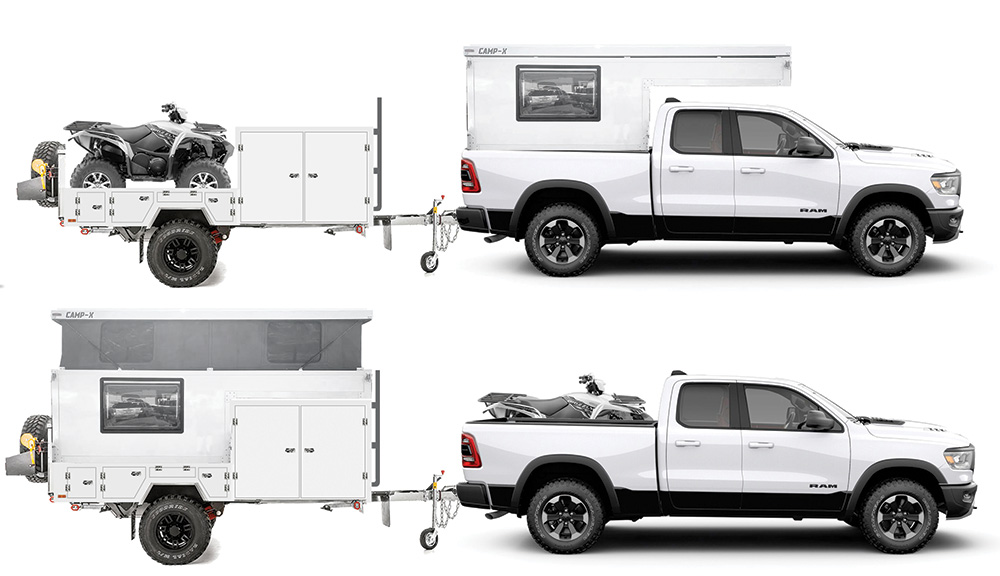
Camper Shell Mounted Pickup pulling Camper Trailer
Interestingly, I am considering this option. I currently have a Sprinter Camper and a pickup truck which is wired with an electrical harness to the rear for power to a truck camper if I choose to add one. However, I am considering selling the Sprinter camper and purchasing a pull-behind 24-foot camper trailer, and then purchasing a minimalist truck shell with an interior access rooftop tent. I believe this will improve my options when utilizing the right tools for the job at hand depending on the adventure. What I find appealing about this option is that I can mount the minimalist overland truck shell with an incorporated tent to the truck and then pull behind it a livable camper trailer. I can park the trailer as a base camp and explore the area on overnight overland adventures with the truck and camper shell. On other adventures, I can leave the trailer home and take weekend overland trips with the truck and shell tent, and even if I so choose, mount my motorcycle to the rear bumper. On longer trips, I will have to endure more arduous maneuvering with a long tow, but I believe overall that the variety of options for how I use the setup will overshadow the down side.
Here’s the details.
Pros:
- Speed to departure (improved over the previous options)
- Full-time storage of complete camping system
- Onboard kitchen, water, propane, power, refrigeration
- Off-road access to remote destinations
- Improved safety when sleeping (human/animal interaction)
- No camping restrictions in bear country (National Parks)
- Optional online camping services (Harvest Host – must have onboard services)
- Ample storage space for additional gear (paddle boards, surf boards, fishing)
- Usage Flexibility for multiple types of adventure travel
- Removable shell for truck hauling usage
- Low profile rooftop tent system
- Tiered usage (pull trailer to destination base camp, then overnight overlanding)
Cons:
- Cost of entry (camper trailer cost plus the cost of a overland truck shell)
- Decreased fuel efficiency (caused by weight and drag pulling trailer)
- Inconvenient in urban areas for parking and maneuvering (depending on adventure)
- Limited off-road access with trailer in tow (if utilizing entire setup)
- Limited stealth camping options in urban environments, etc.
So, as you can see, there’s a lot to consider when looking at the various options for an adventure rig and it all comes down to what is important for you and what kind of adventure travel you enjoy with your vehicle.
Interestingly, I have considered building my own modular trailer concept with removable parts for multiple options and believe such a trailer concept would fare well in the marketplace.
Here are some conceptual designs I created to illustrate the modular trailer concept.

